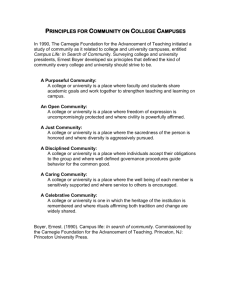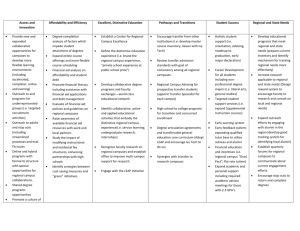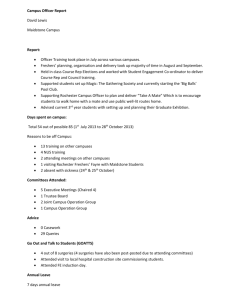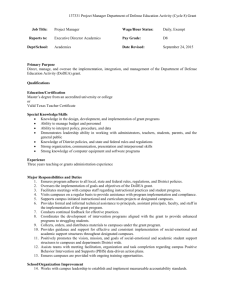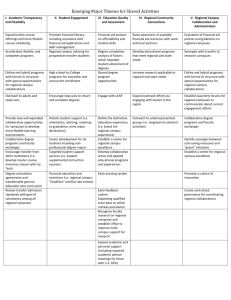IT Service Delivery - Mission Excellence
advertisement
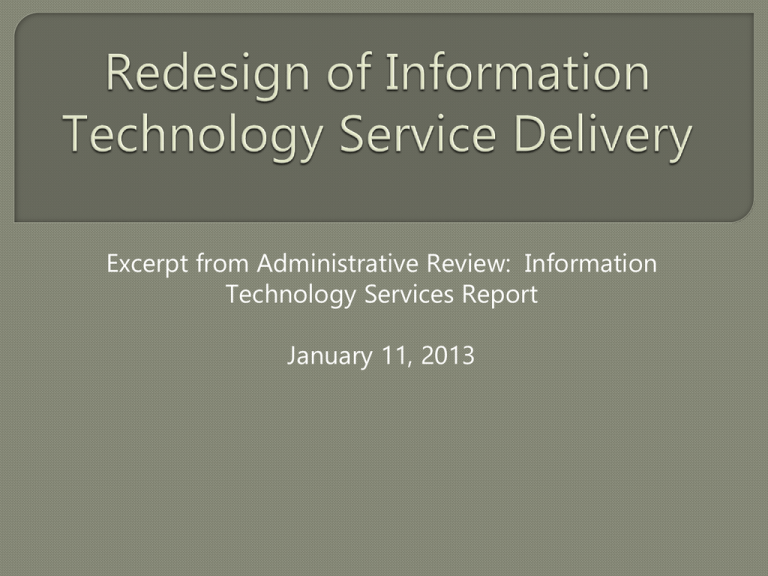
Excerpt from Administrative Review: Information Technology Services Report January 11, 2013 Key attributes of an optimal system for delivery of Information Technology • Increase focus on academic technology • Locate services close to students and faculty • Flexibility • Innovation • Quality • Accountability • Affordability Goal – To create a seamless information technology delivery system which is responsive to the needs of students, faculty, leadership, and administrators. The delivery system must: • • • • Place services close and highly accessible to the end user Provide for quality, innovation and flexibility Operate efficiently and at reasonable cost Deliver a responsive and satisfactory user experience The COMMITMENT and Guarantee • To become the preferred provider for internally delivered services and the preferred administrator for externally acquired services. • Service level agreements in place for all services and a guarantee to support alternative delivery if agreed-upon service levels are not met. FY16 estimated structural savings $410k, staff reduction 3 Implement alternative governance structure • Establish governance and organizational models to create accountability and responsibility for IT Immediately charge UMS Chief Information Officer to provide leadership and responsibility over all IT Develop relationship and communications process with Presidents Council Create Academic and Finance governance councils to oversee and direct the CIO and IT strategy Restructure management functions to remove silos, promote collaborative service delivery and reduce expense Implement policies on architecture, standards, project management and IT procurement, other policies as needed or directed Charter an IT Standards and Procurement committee to guide practices Current State – Campus and system leaders are autonomous, decisions made based on operational expedience or campus preference, replication, redundancy and unique solutions are prevalent. Future State – Uniform decision making, best of breed can be exploited, common infrastructure, shared services with quality and performance measured and accountable No direct savings estimated Policies and practices to provide management oversight and inform leaders, administrators, technical staff and innovators Communication Performance Quality of services Assessment Architecture Policy Procurement Staff management Strategic Planning Initiative management/approval RFP/Contract Review Process Current State – Existing policies are weak and limited in scope and guidance. Consistency in key areas around architecture, planning, procurement of IT, including oversight do not exist. Future State – Well designed policies provide leaders with a mechanism to direct information technology strategy, management and investment. Regular review provides senior level managers with direct impact on ongoing investment and innovation. FY16 estimated structural savings $50k, staff reduction 0 Actively pursue cloud or SaaS sourcing of enterprise systems • Oracle PeopleSoft, includes MaineStreet and Campus Solutions • BlackBoard Learn, Learning Management System • Advance, development office system Seek Advantages • • • • Best Practice implementations Uniformity within UMS and to other users Available support and training systems State of the art technical support Current State – Systems are customized and data management is inconsistent. Local experts need continuous training to keep up and updates are difficult to implement. There is no flexibility in staff for emergencies or significant initiatives. Future State – Migrate our systems and processes to best practices supported across vendor user base. Vendor responsible for upgrades, uptime, performance, training and implementation of approved new modules. No direct savings estimated Investigate and implement a new funding strategy to recover costs of shared and centralized services • Establish true rate based assessments for all shared services Campuses pay for services as used Campuses manage cost by controlling the volume of services used Servicing entity responsible for managing to the budget and within the revenue achieved Cost comparisons/benchmarking regularly performed against peers and outsources solutions Current State – IT is funded by a variety of fees, allocations, grants and contracts, with each campus and system office operating differently. Some models are better than others, but record keeping and flexibility is limited based in the current model. Future State – A rate based system to recover costs for services, allowing campuses to manage the services consumed and to control costs. Rate based services allows for strong benchmarking and strategic sourcing where appropriate. It also allows sharing of resources through a model of cost recovery and distribution. FY16 estimated structural savings $1,040K, staff reduction 14 Consolidate management and delivery of campus and system support and help desk services • Select one Campus and IT director to lead the service (based on competency and infrastructure capability) Backup services located at other campuses • Establish a single service management system for use at all locations Centralize or outsource end user provisioning, management and support functions Current State – campus and system support unique at each location. Limited coordination, significant silos exist, some students and faculty negatively impacted by lack of consistency and access. Future State – Seamless delivery system, single point of contact, campus direct service remains intact, uniform training, expansion of service hours, measured response, metrics kept, analyzed and shared. FY16 estimated structural savings $160K, staff reduction 1 Consolidate Data Center locations, management and operations • Virtualize servers where practical • Reduce locations and staff • Consider outsourcing of some functions • Share data center infrastructure and costs with other public entities, research or higher education institutions Current State – Campuses have small data centers and individual computing assets at multiple locations. Each is free to determine its own strategy related to its infrastructure. Systems are replicated at most campuses. Future State – Infrastructure assets will be located in lights out, highly secure and well equipped areas. Decisions regarding virtualization and server management will be coordinated. Security improvements and cost/staff resources saved by uniformity and co-location. FY16 estimated structural savings $155K, staff reduction 1 Unify communications systems under one management structure by a single campus entity • All voice services managed through a shared services model, campus located staff to be shared across system • Wide, local and wireless area networks provided as shared service • Consider outsourcing of some functions • Expand network infrastructure sharing and costs with other public entities. research or higher education institutions Current State – System and Campuses manage these services in a variety of ways and with variances. Unique attributes and investment strategies inflate cost for some, increase risk for others. Future State – A unified approach achieves uniform training and protocols, allows sharing of staff across campuses, properly places voice in with data and video as a converged technology which can be strategically managed. Wireless and voice infrastructures can be upgraded uniformly and as a priority. FY16 estimated structural savings $88K, staff reduction 2 Restructure the delivery of end user technology • Reduce the number of general purpose lab units by 10% per year for three years, encourage and support “bring your own device” strategy • Pilot, then expand, virtual desktop delivery of tools and access to UMS software and data • Consolidate or outsource end user device delivery, set up and decommissioning • Implement mobility where efficient and cost effective Current State – Each campus and system has their own approach, process and life cycle for end user devices. Data is not maintained on total cost of ownership. Each campus has its own set of images, based on user needs. Future State – A unified approach establishes a common platform, reduces anomalies and makes remote access and unified support more easily accomplished. Services to users will become fast and seamless with uniform images, common support access points and extended time periods for support. FY16 estimated structural savings $1,355K, staff reduction 9 Systemically identify, review, and organize IT services into a shared service model with campus IT management, including: • Learning Management Systems • Web development services • Academic Technologies Panopto/Course Capture ITV Video conferencing Social media • Additional Academic focused services and support for campus managed shared services Current State - Services provided at some campuses and system office overlap or are redundant. Decisions made locally create global implications (LMS or course capture tool products are examples) Future State – IT solutions provided as a shared service becomes the first option, rather than an unique systems. Common tools, implemented uniformly, improves training, usability and transportability to other campuses or users. Available January 30 through February 15, 2013 (Redesign Survey) For more information or if you have additional questions please contact: Cathy Caron at 973-3261 or cathy.caron@maine.edu
